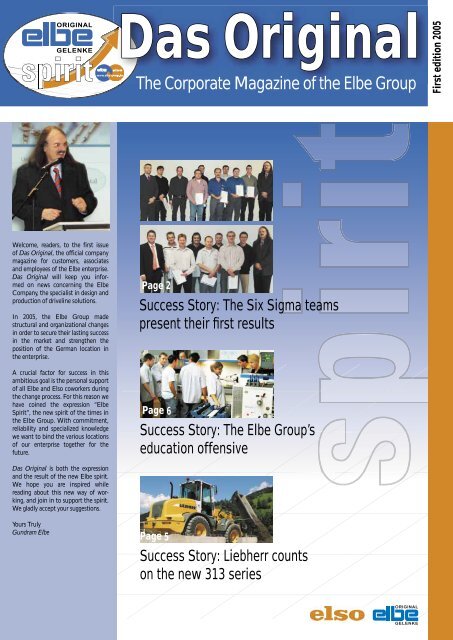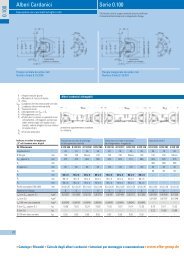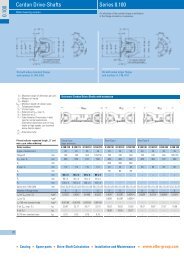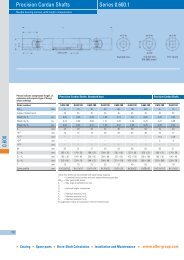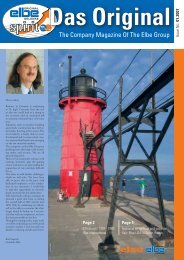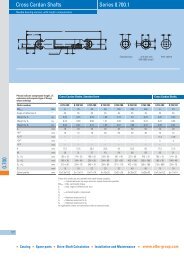Six Sigma teams are presenting their results Successful
Six Sigma teams are presenting their results Successful
Six Sigma teams are presenting their results Successful
Create successful ePaper yourself
Turn your PDF publications into a flip-book with our unique Google optimized e-Paper software.
Das Original<br />
The Corporate Magazine of the Elbe Group<br />
First edition 2005<br />
Welcome, readers, to the first issue<br />
of Das Original, the official company<br />
magazine for customers, associates<br />
and employees of the Elbe enterprise.<br />
Das Original will keep you informed<br />
on news concerning the Elbe<br />
Company, the specialist in design and<br />
production of driveline solutions.<br />
In 2005, the Elbe Group made<br />
structural and organizational changes<br />
in order to secure <strong>their</strong> lasting success<br />
in the market and strengthen the<br />
position of the German location in<br />
the enterprise.<br />
A crucial factor for success in this<br />
ambitious goal is the personal support<br />
of all Elbe and Elso coworkers during<br />
the change process. For this reason we<br />
have coined the expression “Elbe<br />
Spirit”, the new spirit of the times in<br />
the Elbe Group. With commitment,<br />
reliability and specialized knowledge<br />
we want to bind the various locations<br />
of our enterprise together for the<br />
future.<br />
Page 2<br />
Success Story: The <strong>Six</strong> <strong>Sigma</strong> <strong>teams</strong><br />
present <strong>their</strong> fi rst <strong>results</strong><br />
Page 6<br />
Success Story: The Elbe Group’s<br />
education offensive<br />
Das Original is both the expression<br />
and the result of the new Elbe spirit.<br />
We hope you <strong>are</strong> inspired while<br />
reading about this new way of working,<br />
and join in to support the spirit.<br />
We gladly accept your suggestions.<br />
Yours Truly<br />
Gundram Elbe<br />
Page 5<br />
Success Story: Liebherr counts<br />
on the new 313 series
2<br />
Das Original<br />
<strong>Six</strong> <strong>Sigma</strong>:<br />
a successful beginning in the Elbe Group.<br />
If you heard about Black and Green Belts in the<br />
halls and the cafeteria in the last few months, it had<br />
less to do with martial arts than with a new way to<br />
lead our company successfully into the future.<br />
Globalization and tough competition make<br />
it difficult to meet that goal, but with <strong>Six</strong> <strong>Sigma</strong><br />
Elbe has found the method it believes will meet the<br />
challenge.<br />
n. OK<br />
reduced<br />
diffusion<br />
OK<br />
n. OK<br />
Too far left?<br />
OK<br />
centralized<br />
process<br />
OK<br />
What is behind the term <strong>Six</strong> <strong>Sigma</strong>? <strong>Six</strong> <strong>Sigma</strong><br />
is a method for improving<br />
processes in<br />
an organization. The<br />
term sigma originates<br />
in statistics, and means<br />
the standard deviation<br />
(dispersion) of a<br />
process. The number<br />
of standard deviations<br />
between the average<br />
and the maximum<br />
deviation of the process<br />
gives the sigma level of<br />
the process. The optimum is 6 times or less, from this<br />
we get the name <strong>Six</strong> <strong>Sigma</strong>. In practice, this would<br />
correspond to approximately 3.4 defects per million<br />
parts or procedures.<br />
In the picture (from left): B. Klenk, M. Noschka, M. Ketterle, S. Serway, A. Loncar, F. Possmayer,<br />
M. Vukovic, A. Löffler, H. Ilshöfer, G. Elbe. In the picture <strong>are</strong> missing: O. Sinn.<br />
Standard deviation? Higher mathematics? Or an<br />
equation beautiful only for mathematicians? Confused?<br />
The Black Belts: M. Ketterle of Elbe and his<br />
colleagues C. Endres<br />
and T. Sollner from<br />
Elso explain this by the<br />
following example:<br />
Attempting to pour<br />
water into a glass from<br />
a watering can is clearly<br />
going to put a lot of water<br />
around the glass.<br />
Should we think<br />
of such a process as<br />
“capable”? Surely not.<br />
In <strong>Six</strong> <strong>Sigma</strong> jargon the<br />
capability of a process is described by the key words<br />
“dispersion” and “centering”.<br />
In the watering can example, in order to make<br />
the process at all controllable, the width of the water<br />
stream would have to be reduced. Those things that<br />
influence the width of the stream might be the angle<br />
of inclination of the watering can and the form of the<br />
spout.<br />
After that, adjusting the position of the can so<br />
that the stream hits the middle of the glass (centered)<br />
should make the process capable.<br />
This procedure is applicable in almost all processes<br />
of a business.<br />
Here, in a nutshell, is what makes <strong>Six</strong> <strong>Sigma</strong>: Recognition<br />
of the significant<br />
factors that<br />
influence a process,<br />
determining<br />
and adjusting the<br />
optimum values<br />
for these factors<br />
and lasting control<br />
of the <strong>results</strong>.<br />
In order to<br />
reach this goal,<br />
<strong>Six</strong> <strong>Sigma</strong> uses<br />
five project phases, represented by the DMAIC<br />
Cycle. DMAIC stands for Define, Measure, Analyze,<br />
Improve, and Control. In the first phase, the problem<br />
is defined and the goal for the project is determined,<br />
after which a judgment is made of the current process<br />
capability. The Analyze phase evaluates the measurement<br />
<strong>results</strong> and tracks down the actual causes of the<br />
problem. Finding the solution follows, and an action<br />
plan for lasting process improvement is produced. In<br />
the last phase, verification<br />
is made<br />
that the process<br />
improvements<br />
made <strong>are</strong> permanent.<br />
The improvement<br />
process<br />
is carried out by<br />
trained coworkers.<br />
According to the<br />
scope and length<br />
of <strong>their</strong> training, they <strong>are</strong> called Yellow Belt, Green<br />
Belt or Black Belt. A Black Belt is responsible for<br />
project planning and execution of the <strong>Six</strong> <strong>Sigma</strong> methods<br />
and tools, for example. A Yellow Belt has basic<br />
knowledge, while a Green Belt leads the <strong>Six</strong> <strong>Sigma</strong><br />
projects. Although <strong>Six</strong> <strong>Sigma</strong> leads to significant<br />
quality improvements, it has been started in only 200<br />
German companies and only 1200 in the US.<br />
In the picture (from left): H. Kneuer, T. Dünninger, M. Koch, T. Endres, J. Beauchamp, S. Hömer, C. Endres,<br />
T. Söllner, G. Elbe. In the picture <strong>are</strong> missing: U. Schwappach, R. Huth.<br />
Therefore Elbe is again a pioneer!
3<br />
<strong>Six</strong> <strong>Sigma</strong>: 7 projects in Hofheim and<br />
Bietigheim-Bissingen successfully<br />
presented.<br />
On the 22 nd and 23 rd of November, 2005 the<br />
first 7 projects in the Elbe Group were presented by<br />
the Black and Green Belts, to much applause from<br />
the 75 coworkers.<br />
The <strong>results</strong> of the presentation were astonishment,<br />
or, better, enthusiasm. It was plain to see how<br />
much hidden potential that can contribute to the<br />
success of the enterprise was uncovered. Each project<br />
is already well underway and producing <strong>results</strong>.<br />
Topics were as follows:<br />
Elso project 1, Reduction of the preparation times<br />
for turning<br />
Elso project 2, Rejection rate for cast parts<br />
Elso project 3, Reduction of grinding time for flanges<br />
Elbe project 1, Reduction of non-productive times on<br />
bottleneck machines<br />
Elbe project 2, Machine utilization on the “Sweden line”<br />
Interview with Mr. Gundram Elbe<br />
about <strong>Six</strong> <strong>Sigma</strong>.<br />
Mr. Elbe, what made you decide to introduce<br />
<strong>Six</strong> <strong>Sigma</strong> in your business?<br />
Elbe:<br />
Actually, the occasion for me to introduce <strong>Six</strong> <strong>Sigma</strong><br />
was an invitation from our customer Caterpillar in<br />
the USA. The philosophy immediately convinced<br />
me.<br />
Philosophy, not a marketing ploy?<br />
Elbe:<br />
Exactly. This philosophy, which isn’t yet implemented<br />
in many companies, is not a ploy. It must be made<br />
a part of life, every day, from each coworker to the<br />
executive management.<br />
So, what does this mean in practice?<br />
Elbe:<br />
We had to find a tool to make sure that Elbe remains<br />
competitive in the future, to secure the long term<br />
business success. With <strong>Six</strong> <strong>Sigma</strong>, we can affect all<br />
key <strong>are</strong>as of the business in a practical way and improve<br />
our net value added chain.<br />
Das Original<br />
Elbe project 3, Additional time of the welding<br />
Elbe project 4, Utilization in the shipping<br />
Comments on <strong>Six</strong> <strong>Sigma</strong>:<br />
This topic is very interesting for me. The potential and actual optimization<br />
of the work shown in this presentation makes us more<br />
competitive, and consequently makes it possible to help guarantee our<br />
jobs in the future.<br />
The Elbe work council faces the <strong>Six</strong> <strong>Sigma</strong> project openly. Surely there<br />
is criticism voiced amongst our coworkers. Because of this, I hope that<br />
information meetings will be held and the topic communicated widely.<br />
This can help to eliminate misunderstandings, and help with a positive<br />
implementation. Also, it should be emphasized that the workers and<br />
the work <strong>are</strong> the main issue, so that we have a chance to reduce some<br />
of the “grunt work”.<br />
Bernd Sollner, chairman of the Elbe work council.<br />
The introduction takes place with the purpose to make us more economically<br />
competitive, minimize cost and improve the daily processes.<br />
<strong>Six</strong> <strong>Sigma</strong> specializes in improving processes, as we have understood<br />
it so far.<br />
Before today, there was only one other way of doing an improvement<br />
process, e.g. tests to improve the set-up times.<br />
In conclusion: I hope that the <strong>Six</strong> <strong>Sigma</strong> projects that have already<br />
been started have been tested before they were implemented, and<br />
have been started properly. I’m saying that it’s important to involve the<br />
works committee and the coworkers during the implementation of <strong>Six</strong><br />
<strong>Sigma</strong> projects, but even more important, that this won’t result in any<br />
disadvantages for the coworkers.<br />
Matthias Wernthaler, chairman of the Elso work council.<br />
So, <strong>Six</strong> <strong>Sigma</strong> means to improve competitive abilities?<br />
Elbe:<br />
Yes, with <strong>Six</strong> <strong>Sigma</strong> questions everything: How good<br />
is our product? Are the actual production costs too<br />
high? Are we selling at the right price? What about<br />
service? Can we improve quality? How is our company<br />
image?<br />
How was this issue accepted by your workforce?<br />
Elbe:<br />
Our black and green belts fully involved everyone<br />
that was affected by those process changes right<br />
from the beginning. Everyone cooperated without<br />
reservation.<br />
Which criteria were used to select the black and green<br />
belts?<br />
Elbe:<br />
The executive board, assisted by Bernd Klenk and<br />
Horst Kneuer chose employees that have technical<br />
know how, but also those that have shown administrative<br />
capabilities.<br />
Does everyone have the chance to be involved?<br />
Elbe:<br />
Dedicated employees always have bright prospects in<br />
the Elbe group.<br />
High expectations and more projects.<br />
For six months now, the Elbe Group has devoted itself fully and completely to the quality offensive by means of <strong>Six</strong> <strong>Sigma</strong>. Meanwhile, three Black<br />
Belts and 14 Green Belts <strong>are</strong> ready to insure quality, and Yellow Belts will soon train in <strong>their</strong> turn. The Black and Green Belts will get a TUV Certification.<br />
„We go into the project with high expectations“, manager Gundram Elbe says. „Avoiding mistakes means less rework, less inefficiency,<br />
and improves quality. This is true in the production as well as in the administrative <strong>are</strong>as of the group. We improve our ratio<br />
of <strong>results</strong> to effort, and become more competitive. Yellow Belts <strong>are</strong> to be trained and to integrate the new spirit in the Elbe Group,<br />
as Mr. Klenk and Mr. Kneuer emphasized again.
4<br />
Das Original<br />
Action!<br />
The Management<br />
says thank you.<br />
There will be a special event for all participants<br />
in the <strong>Six</strong> <strong>Sigma</strong> training in Boxberg, between Würzburg<br />
and Heilbronn on March 25 th 2006: Driver improvement<br />
training at the Bosch proving grounds.<br />
Why <strong>are</strong> we doing this? The executive board wants<br />
to say thanks to all participants for <strong>their</strong> extra efforts<br />
during the last few months.<br />
Photo: Bosch<br />
„“Special efforts should be rewarded appropriately”<br />
C.E.O Gundram Elbe justifies the extraordinary<br />
trip for his Green- and Black belts. “Normally the<br />
curve performance of the Porsche Carrera GT is<br />
tested here, but today our colleagues can experience<br />
the need for speed, too.” When the tires lose <strong>their</strong><br />
grip on the wet proving ground at a speed of 120<br />
km / h, the level of adrenaline will explode. Now it is<br />
all about staying cool. But don’t panic, as the instructor<br />
will always give precise instructions via radio how<br />
to handle the car during aquaplaning.<br />
However, the precise transition between clutch,<br />
accelerator and brake should be an easy task for people<br />
that have proven themselves in <strong>Six</strong> <strong>Sigma</strong>.<br />
Gasoline in the blood<br />
But the Bosch proving grounds still have more to<br />
offer. On a total of 24 squ<strong>are</strong> kilometers the participants<br />
get the chance to prove <strong>their</strong> driving abilities<br />
on special tracks. Slalom, abrupt lane changes, braking<br />
and skilful evasion will take place, as well as driving<br />
on narrow serpentines and a passing track. If this<br />
isn’t enough, test of top speed taking the driver and<br />
his car to the limits while driving round the proving<br />
grounds. After such exciting hours there will be lots<br />
of „Gasoline” to discuss.<br />
Elbe Spirit: Insight into the future.<br />
Mr. Gebhardt, why „Elbe Spirit“?<br />
Gebhardt: The Elbe Group is committed to the two<br />
production locations in Germany. The cost pressure<br />
on the product from the low wage countries is<br />
enormous. In order to remain attractive for existing<br />
customers, and win new customers, our business<br />
strategy consists of quality, flexibility and on-time<br />
delivery as well as the goal of continuous productivity<br />
improvement.<br />
Is this what „Elbe Spirit“ means?<br />
Gebhardt: The Elbe Spirit is the new attitude in<br />
the Elbe group. The management provides the tools<br />
and a not insubstantial investment in the German<br />
locations. However, these <strong>are</strong>n’t the only things<br />
that will determine the success of the business in<br />
the international competition of the future. We<br />
will need technical knowledge, commitment and<br />
reliability from each individual coworker in order to<br />
insure the success of our business in the future. Only<br />
as a team can we go ahead to improve the conditions<br />
for success.<br />
How is the Elbe Spirit connected with <strong>Six</strong> <strong>Sigma</strong>?<br />
Gebhardt: With <strong>Six</strong> <strong>Sigma</strong>, we introduced a system<br />
that helps make it possible to improve all our production<br />
processes in Elbe and Elso. This is an important<br />
component of the Elbe Spirit. And I am confident<br />
that each coworker, including myself, can contribute<br />
something every day, to bring our goal a bit closer.<br />
What <strong>are</strong> your wishes for the Elbe Group for 2006?<br />
Gebhardt: Success!!! And the realization that this<br />
success in the Group comes not only from the management,<br />
production or sales, but from the hard<br />
work and the commitment of each individual.<br />
This sounds almost as if you expect a real wave will be<br />
started with the Elbe Spirit?<br />
Gebhardt: The bigger this wave becomes, the more<br />
successful the year 2006 and the following years will<br />
be.<br />
Interview partner: Ralf Gebhardt<br />
Marketing Manager, Elbe Holding GmbH & Co. KG
Liebherr puts the 0.313 on <strong>their</strong> new project.<br />
Liebherr has always favored reliability from its<br />
suppliers. Now, the new development from Elbe,<br />
the 0.313, could score very well with Liebherr.<br />
The new 514 wheel loader is completely equipped<br />
with joint shafts from Elbe. Elbe has been a listed<br />
Liebherr series supplier for decades.<br />
5<br />
Das Original<br />
In the <strong>are</strong>a of earth moving machines, Liebherr<br />
Bischofshofen employs approximately 780 workers in<br />
an extensive wheel loader program.<br />
The high demand for quality that Liebherr makes<br />
on its product is also guaranteed throughout the<br />
spectrum of products at Elbe. In the new 514 loader,<br />
Liebherr uses axles from a renowned manufacturer,<br />
who also uses Elbe as <strong>their</strong> primary supplier of double<br />
joint shafts. After recent successful field tests, the<br />
new joint shaft 0.313 is also included. This shaft was<br />
developed with a double centered joint on both ends,<br />
for the rear axle connection. However, first things<br />
first:<br />
Approximately one year ago, 4 prototypes of<br />
the shaft 0.313.115.8011 were sent to Liebherr in<br />
Bischofshofen (Austria). The shafts were installed<br />
into the field test machines L514/790. After approximately<br />
4000 hours of operation, one of these shafts<br />
was sent back to Elbe for evaluation.<br />
Results from the field test:<br />
The shaft showed no external damage. The seals<br />
at the joint bearings and the extension as well as the<br />
centering device were still in good condition. Moving<br />
the joints on each end showed no irregularities. Both<br />
joints turn while bent with no noticeable difficulty.<br />
The extension moved easily. The balance for the shaft<br />
was checked, and still in order.<br />
Because of the good <strong>results</strong> of the examination,<br />
it was decided that it was not necessary to dismantle<br />
the joints.<br />
Regreased and fully<br />
functional, the shaft<br />
could be sent back to<br />
the Liebherr Company<br />
with a good test report.<br />
Reliability in<br />
every sense.<br />
Mr. Wörndl, Builder/Designer for wheel loaders<br />
at Liebherr in Bischofshofen, swears by both the<br />
Elbe products and the smooth communications with<br />
Bietigheim-Bissingen.<br />
Editor, Das Original: We don’t want you to give<br />
away any company secrets, but can you say how many<br />
of the type 514 <strong>are</strong> produced annually?<br />
Wörndl: We sell 150 type 514 wheel loaders annually,<br />
performing <strong>their</strong> daily duties reliably around<br />
the world.<br />
Editor, Das Original: What impressed you about<br />
your work with Elbe?<br />
Wörndl: The fast reaction and above all, the competence,<br />
of the coworkers in the Elbe company.<br />
Editor, Das Original: What was the decisive factor<br />
to use the new shaft?<br />
Wörndl: First, of course, was the successful field<br />
test, where the shaft showed its reliability in over<br />
4000 hours in the 3-layer-test. Also, however, the<br />
positive relationship that Liebherr has had with Elbe<br />
for years.<br />
Photo: Liebherr<br />
Photo: Liebherr
6<br />
Das Original<br />
Investment for the future.<br />
The Elbe Group creates more training<br />
positions starting in 2005!<br />
The unemployment situation for the youth in<br />
Germany is disastrous. For 2004, the official count<br />
of unemployed teenagers was over half a million.<br />
342,000 more were in government educational programs,<br />
from all government levels, so therefore were<br />
not counted in the official unemployment statistics.<br />
In sum, 16.9 percent of youth in Germany have no<br />
apprenticeship training position or work place and<br />
therefore no prospects for the future. These numbers<br />
were reported in the magazine “Wirtschafts Woche”<br />
(Economics Week) in an appeal to the federal agency<br />
for work.t.<br />
Trainees at Elbe ...<br />
... and Elso<br />
But is not really black times - at least not in<br />
the Elbe Group, with, at the moment, 43 trainees<br />
employed. 24 of those get <strong>their</strong> occupational training<br />
at Elbe in Bietigheim. „For us, it’s clear that<br />
training is an investment in the future”, says Heinz<br />
Friederich, master mechanic and long time trainer.<br />
“The management has made it clear that it is committed<br />
to the main location in Germany - we have to<br />
insure that in two or three years, we have no lack of<br />
specialists.” In order to prevent this, Elbe started the<br />
education offensive in 2005. In plain language, they<br />
<strong>are</strong> calling for a new attitude, that of creating more<br />
jobs, and acceptance of new two year programs such<br />
as “Storage-Craftsman” and “Plant and Machine<br />
Operator”. It can be said that trainees <strong>are</strong> in good<br />
hands with Heinz Friederich, so far 92 industrial<br />
trainees have gone through his school.<br />
The new generation is also being taken c<strong>are</strong> of at<br />
Elso in Hofheim. There, 19 industrial trainees learn<br />
<strong>their</strong> occupation. Georg Müller learns Machine Tool<br />
Operations: “When I have questions, I can always<br />
turn to my colleague in a higher year of apprenticeship.<br />
Something unusual is having lunch with<br />
the trainers and the management. The others in the<br />
vocational school were pretty surprised when I told<br />
them about it.”<br />
Practice is essential.<br />
Hearing this from his protégé gives proof to trainer<br />
Ludwig Laubender that the Elbe Spirit concept<br />
is on the rise: “I have been in this business since 1974<br />
and have had the opportunity to pass on my knowledge<br />
to 80 trainees. The feeling of working together<br />
and friendliness <strong>are</strong> quite important. When you have<br />
that, technical knowledge falls on fertile ground.”<br />
Emphasizing the relationship to practice and seeing<br />
how it all fits in the big picture <strong>are</strong> also important at<br />
Elbe. Laubender: “We organize trips to subsidiaries,<br />
suppliers and customers regularly. For the trainees, it<br />
helps to broaden <strong>their</strong> view if they can see things like<br />
how the raw material is produced, or how a customer<br />
uses Elbe’s technology.” A recent trip in October took<br />
the 43 trainees of Elbe and Elso to Aalen to visit a<br />
forging supplier. As a surprise, it included a visit to<br />
the cart track in Backnang. Education in the Elbe<br />
group - a pure enjoyment? “Of course we expect<br />
good performances”, Ludwig Laubender explains.<br />
“And our eleven education representatives assess the<br />
progress of the apprentices regularly.”<br />
The “Council of Eleven” found no fault with<br />
Sonja Müller, Klaus Hau, Stefan Frees and Alexander<br />
Sittler. The four Machine Tool Technology trainees<br />
passed <strong>their</strong> skilled worker exams with a commendation<br />
of the IHK (Chamber of Commerce and<br />
Industry). Sonja Müller: “Our study group in the<br />
cafeteria helped me very much. It is motivating to<br />
cram for examinations in a group. I am very proud to<br />
be rewarded for my hard work in this way.” Results of<br />
the education offensive in the Elbe Group? Keep it<br />
up, we <strong>are</strong> going the right way.
7<br />
Mark Sirp,<br />
first year trainee:<br />
What I have learned so far is exactly what I expected from<br />
my apprenticeship. Not only how to use a file, but right from<br />
the beginning sound knowledge that I can use to build my<br />
future on.<br />
In the picture:<br />
Mr. Friederich, trainers at Elbe with Mark Sirp .<br />
Das Original<br />
Mr. Friederich and Mr. Laubender, what goals <strong>are</strong> the<br />
Elbe Group pursuing with the education offensive?<br />
Friederich: We <strong>are</strong> doing our part to reduce unemployment<br />
in the youth. And we train reliable personnel,<br />
who we know will have a place after <strong>their</strong> education.<br />
As an example, a former trainee is a manager in the<br />
Italy office today.<br />
Laubender: Where other people only speak, we want<br />
to make an active contribution to help with the youth<br />
unemployment.<br />
How does this work in practice?<br />
Laubender: With Elso, in 2005 we started six new<br />
trainees. This was fifty percent more than in years<br />
previous.<br />
Friederich: In 2005, at Elbe, we started five instead of<br />
four Industrial Machinists. Also, four Plant/Machine<br />
Operator jobs were created as well as two Storage-<br />
Craftsman persons. In the commercial <strong>are</strong>a, we<br />
added two Industrial Clerks.<br />
What does the educational system look like in the Elbe<br />
Group?<br />
Friederich: Among other things, Elbe favors Learning<br />
Groups. A trainee from a higher year of apprenticeship<br />
helps younger apprentices with <strong>their</strong> learning.<br />
They meet in the cafeteria and go through the<br />
theoretical material again before tests. This method<br />
has proved itself, because three trainees passed <strong>their</strong><br />
examinations for Industrial Machinist this year with<br />
a commendation.<br />
Laubender: At Elso developed our own education<br />
philosophy over the years. A „godfather“, normally<br />
from the third or fourth year of apprenticeship, is<br />
assigned to each occupational trainee, and watches<br />
over the beginner. So, everything is passed down year<br />
by year. In addition, our trainees <strong>are</strong> given the use of<br />
a training island, which includes two PC stations with<br />
CNC simulator and other softw<strong>are</strong>. The trainees can<br />
deepen <strong>their</strong> knowledge of the CNC machines with<br />
this equipment.<br />
This is a large investment in the future.<br />
Friederich: You could probably say that. In 2005, we<br />
have invested 30,000 Euro for a radial arm drill and a<br />
lathe for our training workshop.<br />
Laubender: It isn’t just the material. In the past, we<br />
have had a booth at the job fair in Hassfurt, designed<br />
and built by the trainees. This helps the young people<br />
learn to present themselves in public. We will participate<br />
with our trainees in a job fair again in 2006.<br />
Friederich: Our trainees do artworks from scrap<br />
metal. The Brandenburg Gate, the Leaning Tower of<br />
Pisa, and the Statue of Liberty were sculptures from<br />
last year. A few weeks ago, there was a presentation<br />
of the competition for this year’s group. The assignment<br />
was to create a column to advertise the Elbe<br />
Drive Shaft Service. Awards and cash prizes were<br />
presented from the management. We plan to have a<br />
tower about four meters high, eventually.<br />
Georg Müller,<br />
Trainee in the 3rd training<br />
year: It’s amazing how<br />
unstrained you can work in<br />
the “Learning Island” here.<br />
Practice and theory stand<br />
hand in hand; it doesn’t get<br />
better than this. And a benefit<br />
for us at the vocational<br />
school, we can go farther at<br />
the “Learning Island”, and<br />
deepen our understanding.<br />
In the picture:<br />
Mr. Laubender, trainer at<br />
Elso, with Georg Müller<br />
Heinz Friederich, at Elbe since 1982<br />
• Master Machinist/REFA-Specialist and Workplace<br />
Safety Specialist<br />
• trained 92 industrial trainees<br />
• 24 trainees in the industrial and commercial <strong>are</strong>a<br />
at Elbe now.<br />
Ludwig Laubender, at Elso since 1974<br />
• Master, Mechanical Engineering and Technical/REFA<br />
Specialist<br />
• trained 80 industrial trainees<br />
• working now with Elso’s 19 industrial trainees.
8<br />
Das Original<br />
The new record:<br />
330 years of loyalty. Congratulations!<br />
In the Elbe Group, 12 coworkers hold the longevity<br />
record in our company story this year: 330 years.<br />
Among them <strong>are</strong> two 40 year veterans.<br />
A reason for congratulation and for celebration.<br />
Mr. Elbe, Mr. Kneuer and Mr. Klenk from the<br />
Management gave thanks to our colleagues in our<br />
business for <strong>their</strong> long-time loyalty.<br />
Mr. Sellner and Mr. Wernthaler of the worker’s<br />
committee joined in the congratulations.<br />
Jubilee at Elbe. In the picture<br />
(from the left): Hugo Höhn (25<br />
years), Mrs. Zaja, Tomislav Zaja<br />
(40 years), Mrs. Tzortzis, Francais<br />
Tzortzis (40 years)<br />
In the picture (from the left):<br />
Franz Hatzlhoffer (25 years), Richard<br />
Wilhelm (25 years), Andreas Lochner<br />
(25 years) and Ivan Maras also 25 years<br />
at Elbe<br />
25 years with Elso: Doris Bock, Willi Eiring, Gerald Mock, Bernhard Valtenmeier and Heribert<br />
Zimmermann.<br />
In the picture (from the left): Paul Vierneusel, Gabriele Mock, Gerald Mock, company owner<br />
Gundram Elbe, Ursula Zimmermann, Brigitte Eiring, Matthias Wernthaler, Heribert Zimmermann,<br />
Doris Bock, Willi Eiring, Herbert Bock, Erika Valtenmeier, Manager Horst Kneuer, Bernhard Valtenmeier.<br />
Tell us your opinion!<br />
You have the first edition of Das Original before<br />
you. Do you like it? What would you like to see in<br />
our company publication in the future? Give us your<br />
opinion, suggestions, criticism or praise.<br />
Tell us what you would like to see and read in Das<br />
Original. We look forward to your contributions and<br />
suggestions... tell us everything that makes it more<br />
worth reading for you, in order to fill Das Original<br />
with life.<br />
For those that would like to help us, we have<br />
prep<strong>are</strong>d a few questions. Please pass your answers<br />
on to the office secretary. Thanks in advance for your<br />
contributions.<br />
Everyone that responds will be entered into a<br />
drawing for 10 gifts, to be presented at a meeting of<br />
the worker’s committee.<br />
How well do you like Das Original?<br />
Excellent<br />
OK<br />
Not so good<br />
I would like to see articles on:<br />
Name:<br />
Department:<br />
Imprint<br />
Publisher: Elbe Holding GmbH & Co. KG<br />
Gerockstraße 100, D-74321 Bietigheim-Bissingen<br />
Phone: 07142/353-0, Fax: 07142/353-350<br />
www.elbe-group.de<br />
Responsible for contents: Ralf Gebhardt<br />
Das Original is the Corporate Magazine for customers,<br />
partners and employees of the Elbe Group<br />
Feature way: twice annually<br />
Editorship, project coordination, design and<br />
reproduction:<br />
W.A.S. Werbeagentur Spazierer, Stuttgart<br />
Das Original and all individual contributions and<br />
illustrations <strong>are</strong> protected under the copyright<br />
law.<br />
The published pictures <strong>are</strong> - if not differently indicated<br />
- of the publisher and/or the editorship.<br />
Reproduction in any form or any part only with<br />
permission of the publisher.


